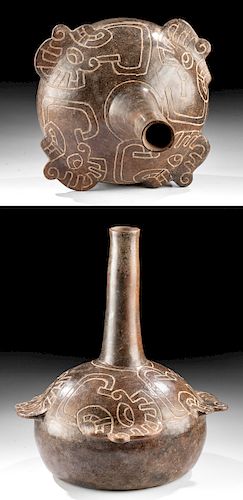Chavin Pottery Bottle w/ Incised Trophy Heads
Lot 17
About Seller
Artemis Fine Arts
686 S Taylor Ave, Ste 106
Louisville, CO 80027
United States
Selling antiquities, ancient and ethnographic art online since 1993, Artemis Gallery specializes in Classical Antiquities (Egyptian, Greek, Roman, Near Eastern), Asian, Pre-Columbian, African / Tribal / Oceanographic art. Our extensive inventory includes pottery, stone, metal, wood, glass and textil...Read more
Estimate:
$3,000 - $6,000
Absentee vs Live bid
Two ways to bid:
- Leave a max absentee bid and the platform will bid on your behalf up to your maximum bid during the live auction.
- Bid live during the auction and your bids will be submitted real-time to the auctioneer.
Bid Increments
| Price | Bid Increment |
|---|---|
| $0 | $25 |
| $300 | $50 |
| $1,000 | $100 |
| $2,000 | $250 |
| $5,000 | $500 |
| $10,000 | $1,000 |
| $20,000 | $2,500 |
| $50,000 | $5,000 |
| $100,000 | $10,000 |
| $200,000 | $20,000 |
About Auction
By Artemis Fine Arts
Oct 3, 2019
Set Reminder
2019-10-03 10:00:00
2019-10-03 10:00:00
America/New_York
Bidsquare
Bidsquare : Exceptional Day 2: Pre-Columbian & Tribal Art
https://www.bidsquare.com/auctions/artemis-gallery/exceptional-day-2-pre-columbian-tribal-art-4453
Day 2 of an important 2-day auction featuring exceptional, museum-worthy examples of Pre-Columbian from the ancient Americas, Native American, African / Tribal, Oceanic, Spanish Colonial and fossils. Artemis Fine Arts info@artemisgallery.com
Day 2 of an important 2-day auction featuring exceptional, museum-worthy examples of Pre-Columbian from the ancient Americas, Native American, African / Tribal, Oceanic, Spanish Colonial and fossils. Artemis Fine Arts info@artemisgallery.com
- Lot Description
Pre-Columbian, Northern Peru in the Jequetepeque Valley, Chavin, Tembladera, ca. 1200 to 1000 BCE. One of the more striking and rare examples of ancient pottery I have seen from this region! A sizeable brownware vessel - with a rounded, flat bottomed body that features four incised trophy heads with sections of their profile images delineated in high relief - placed equidistantly and jutting out around the shoulder. Head-taking was a significant component of ancient Peruvian warfare and religious mythology. A warrior could increase his might and status by capturing prisoners for head-taking. Notice that the mouths are pinned. According to scholar Paul A. Clifford, the fact that the lips of trophy heads are pinned shut " . . . implies that head-taking might mean the acquisition of a slain enemy's power or the prevention of his soul or spirit from harming the killer. Pinning lips shut on the trophy head could inhibit the loss of the soul or power embodied within the head." (Art of the Andes, 1983, p. 251) Size: 8" W at widest point x 9.375" H (20.3 cm x 23.8 cm)
Tembladera pottery is an understudied subject; however, a few interesting theses address this subject. See, for example, Julia T. Burtenshaw-Zumstein's "Cupisnique, Tembladera, Congoyape, Chavin: A Typology of Ceramic Styles from Formative Period Northern Peru, 1800-200 BCE" - https://pdfs.semanticscholar.org/7441/94b54cefa79089fa982048ff95d62fe20fa6.pdf
Provenance: private Hawaii, USA collection; ex-private Hans Juergen Westermann collection, Germany
All items legal to buy/sell under U.S. Statute covering cultural patrimony Code 2600, CHAPTER 14, and are guaranteed to be as described or your money back.
A Certificate of Authenticity will accompany all winning bids.
We ship worldwide and handle all shipping in-house for your convenience.
#148343Professionally repaired from multiple pieces with restoration over the break lines - so skillfully executed and difficult to discern. Collection label on underside of base.Condition
- Shipping Info
-
All shipping is handled in-house for your convenience. Your invoice from Artemis Gallery will include shipping calculation instructions. If in doubt, please inquire BEFORE bidding for estimated shipping costs for individual items.
-
- Buyer's Premium



 EUR
EUR CAD
CAD AUD
AUD GBP
GBP MXN
MXN HKD
HKD CNY
CNY MYR
MYR SEK
SEK SGD
SGD CHF
CHF THB
THB

















